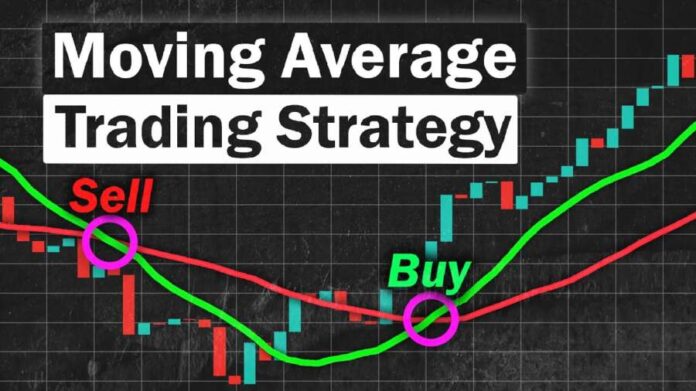If you’re new to trading, you may have heard the term “moving averages” thrown around. But what exactly are moving averages, and how can you use them to improve your day trading strategy?
In this article, we’ll dive into the basics of moving averages and explore the best moving averages for day trading. By the end, you’ll have a better understanding of how to use this powerful tool to make more informed trading decisions.
What Are Moving Averages?
Moving averages are a type of technical indicator used in trading to smooth out price data by creating a constantly updated average price. This helps traders identify trends and potential entry and exit points for trades.
The moving averages method refers to a forecasting method that takes the average of a certain number of past data points and uses it to predict future trends. In trading, this is typically done by calculating the average price of a security over a specific period of time.
Types of Moving Averages
There are three main types of moving averages used in trading: simple, exponential, and weighted.
- Simple moving averages (SMA) are calculated by taking the average price of a security over a specific period of time. Each data point is given equal weight in the calculation, making it a straightforward and easy-to-understand indicator.
- Exponential moving averages (EMA) give more weight to recent data points, making them more responsive to recent price changes. This can help traders identify trends more quickly, but it can also lead to more false signals.
- Weighted moving averages (WMA) give more weight to recent data points, but they also take into account the number of periods used in the calculation. This can help smooth out the data and reduce the impact of outliers.
How to Calculate Moving Averages
Calculating moving averages is relatively simple. To calculate a simple moving average, you would take the sum of all the closing prices over a specific period and divide it by the number of periods. For example, to calculate a 10-day SMA, you would add up the closing prices for the past 10 days and divide by 10.
To calculate an exponential moving average, you would use a slightly more complex formula that gives more weight to recent data points. This formula takes into account the previous EMA, the current price, and a smoothing factor.
How to Use Moving Averages for Day Trading
Moving averages can be used in a variety of ways in day trading. Here are some of the most common strategies for using moving averages to improve your trading:
Identifying Trends
One of the most basic uses of moving averages is to identify trends in the market. By plotting a moving average on a chart, you can see whether the price is generally trending up or down. This can help you make more informed trading decisions and avoid getting caught in a false breakout.
Finding Support and Resistance Levels
Moving averages can also be used to identify potential support and resistance levels. When a stock’s price is above the moving average, it can act as a support level, and when the price is below the moving average, it can act as a resistance level.
Crossovers
Crossovers occur when a shorter-term moving average crosses above or below a longer-term moving average. These can be used as potential entry or exit points for trades. For example, if a 50-day SMA crosses above a 200-day SMA, it could be a bullish signal, and traders may consider buying the stock.
Moving Average Envelopes
Moving average envelopes are a variation of the moving average crossover strategy. They involve plotting two moving averages on a chart, one above and one below the stock’s price. The upper moving average acts as a resistance level, while the lower moving average acts as a support level. When the stock’s price breaks through one of these levels, it can be a signal to buy or sell.
The Best Moving Averages for Day Trading
Now that you understand the basics of moving averages and how to use them, let’s explore the best moving averages for day trading. Keep in mind that the best moving average for you may vary depending on your trading style and the market you’re trading in.
50-Day and 200-Day Simple Moving Averages
The 50-day and 200-day simple moving averages are two of the most commonly used moving averages in trading. The 50-day SMA is often used to identify short-term trends, while the 200-day SMA is used to identify longer-term trends.
When the 50-day SMA crosses above the 200-day SMA, it can be a bullish signal, and traders may consider buying the stock. When the 50-day SMA crosses below the 200-day SMA, it can be a bearish signal, and traders may consider selling the stock.
9-Day and 21-Day Exponential Moving Averages
The 9-day and 21-day exponential moving averages are popular among day traders because they are more responsive to recent price changes. This can help traders identify trends more quickly and make more informed trading decisions.
When the 9-day EMA crosses above the 21-day EMA, it can be a bullish signal, and traders may consider buying the stock. When the 9-day EMA crosses below the 21-day EMA, it can be a bearish signal, and traders may consider selling the stock.
5-Day and 10-Day Simple Moving Averages
The 5-day and 10-day simple moving averages are popular among day traders who are looking for short-term trends. These moving averages are more sensitive to price changes, which can help traders identify potential entry and exit points for trades.
When the 5-day SMA crosses above the 10-day SMA, it can be a bullish signal, and traders may consider buying the stock. When the 5-day SMA crosses below the 10-day SMA, it can be a bearish signal, and traders may consider selling the stock.
Tips for Using Moving Averages in Day Trading

- Use multiple moving averages to confirm trends and potential entry and exit points.
- Consider using a combination of simple and exponential moving averages to get a more complete picture of the market.
- Use moving averages in conjunction with other technical indicators to make more informed trading decisions.
- Experiment with different moving averages and time periods to find the best fit for your trading style and the market you’re trading in.
Conclusion
Moving averages are a powerful tool for day traders looking to identify trends and potential entry and exit points for trades. By understanding the different types of moving averages and how to use them, you can improve your trading strategy and make more informed trading decisions.
Remember to always do your own research and use moving averages in conjunction with other technical indicators to get a more complete picture of the market. With practice and experimentation, you can find the best moving averages for your day trading strategy and achieve greater success in the market.
For more information, visit ApzoMedia






























































